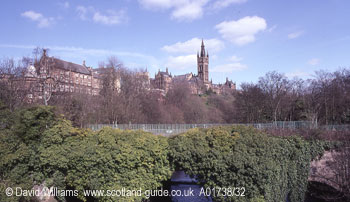Glasgow University was established in 1451 when Pope Nicholas V granted a papal bull to Glasgow`s Bishop William Turnbull. The university was initially accommodated in the Cathedral but it soon outgrew those cramped conditions and moved to High Street. New purpose-built buildings were erected there in the mid-seventeenth century - these are often referred to as the `Old College` - and many famous academics taught there, including Adam Smith and Joseph Black.
Although these were some of the finest and most interesting buildings
in the city, they were in a poor state of repair by the mid-nineteenth
century. This, together with the increasing pollution in the East End,
made the idea of a move to the more salubrious West End a welcome proposition.
In 1846 there were plans to place it on Woodlands Hill but negotiations
with the railway company which had offered to pay for the removal broke
down. In 1864 there was another offer, this time from the City of Glasgow
Union Railway Company, to buy the site (it eventually became the College
Goods Yard) and this allowed the university to move westwards. This time,
Gilmorehill was chosen and the main buildings were erected on the
southern edge of this prominent hill, just across the River Kelvin
from the Woodlands Hill site.
This article is based on the guidebook "The Glasgow Guide".

Glasgow University from Dumbarton Road, with Dumbarton Road Bridge and the River Kelvin in the foreground.